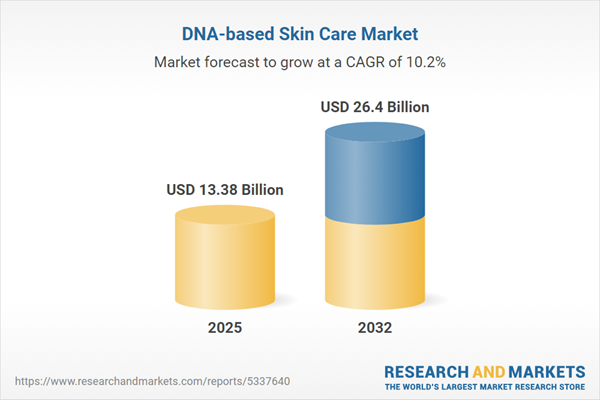Speak directly to the analyst to clarify any post sales queries you may have.
Senior leaders navigating the evolving DNA-based skin care market are encountering new opportunities as genomics and advanced analytics enable precise personalization. Integrating regulatory readiness with technological adaptability supports long-term organizational growth and positions businesses to respond proactively to shifting consumer demands within this dynamic sector.
Market Snapshot: DNA-based Skin Care Market
The DNA-based skin care market is advancing rapidly, with companies leveraging genomic diagnostics and individualized product portfolios derived from personal DNA analysis. As this progression continues, entire value chains are experiencing transformation through improved consumer engagement and more sophisticated operational systems. Executives are focusing on integrating digital technologies and building operational resilience to remain competitive as regulatory requirements evolve. Organizations committed to enhancing compliance and customizing strategies for varied markets position themselves at the forefront of sector innovation.
Scope & Segmentation: DNA-based Skin Care Market
This executive research provides a detailed examination of the drivers, risks, and long-term growth potential influencing strategic decisions in a sector shaped by continued digitalization. Key market segments and their relevance are outlined below:
- Product Types: Tailored creams, serums, lotions, and masks, utilizing DNA profiling to address hydration, anti-aging, and the demand for efficacy-led personalization.
- Genetic Testing Types: Blood-based, buccal swab, and saliva-based tests, offering flexible options to accommodate privacy, invasiveness, and consumer preference for both professional and at-home settings.
- Application Areas: Solutions are designed for concerns like acne, hyperpigmentation, anti-aging, hydration, and sun protection, maximizing outcomes by targeting individual genetic profiles.
- Distribution Channels: Access routes span dermatology clinics, e-commerce, retail pharmacies, specialty beauty providers, and digital platforms, enabling greater consumer reach and tailored product selection experiences.
- End User Segments: The market engages both consumers seeking individualized routines and healthcare professionals implementing advanced therapeutic regimens, extending the value proposition from home to clinic.
- Regional Coverage: Strategic analysis covers the Americas, Europe, Asia-Pacific, and Middle East & Africa, factoring in diverse regulatory environments and localized preferences for growth planning.
- Company Presence: Market innovation is led by organizations including L’Oréal S.A., Beiersdorf AG, Unilever PLC, Estée Lauder Companies Inc., Procter & Gamble Co., Shiseido Company, Johnson & Johnson Services, Amorepacific Corporation, Kao Corporation, and Natura & Co Holding S.A., all of which are at the forefront of tailored solution advancement.
Technology and Channel Integration
Advanced DNA analytics, when effectively paired with multi-channel distribution, are redefining both the user experience and provider capabilities in the DNA-based skin care market. The deployment of digital health tools facilitates scalable personalization while fostering robust data privacy and regulatory compliance. Organizations embracing unified digital platforms generate efficiency gains, optimize their offerings, and seamlessly adapt to technology-driven market requirements.
Key Takeaways: Strategic Insights for Senior Decision-Makers
- Deploying genomics-driven personalization supports targeted consumer needs, building distinct value and meeting increased expectations for individualized products in personal care.
- Collaboration between biotechnology partners and established manufacturers accelerates product innovation and ensures alignment with changing regulatory expectations.
- Adaptive supply chain strategies and proactive sourcing mitigate risks associated with regulatory volatility, supporting operational resilience and business continuity.
- Strong data privacy frameworks and security protocols foster consumer trust while protecting intellectual property as digital adoption expands across the sector.
- Localized approaches to marketing and operational strategy optimize customer engagement and effectively navigate diverse regulatory and consumer environments.
- Leveraging advanced analytics and structured intellectual property management equips organizations to respond swiftly to competitive challenges in a digitally evolving marketplace.
Tariff Impact: Regulatory and Supply Chain Considerations
With anticipated tariff changes in the United States expected in 2025, organizations are reviewing sourcing and logistics models for biotechnological inputs. Efforts include expanding supplier bases and investing in domestic manufacturing capacity to absorb possible cost increases. These strategic actions enhance supply chain resilience and reinforce business continuity plans tailored for the DNA-based skin care segment.
Methodology & Data Sources
The analysis integrates insights from executive interviews, industry expert consultations, published sources, and patent reviews. Scenario analysis, ongoing regulatory review, and data validation processes provide a foundation for actionable business insights and sound decision-making.
Why This Report Matters
- Enables executives to make informed decisions on market entry, portfolio optimization, and expansion by providing reliable, evidence-based guidance.
- Facilitates benchmarking, compliance, and operational planning aligned with best practices in the industry.
- Delivers practical insights on technology adoption and evolving regulations, supporting agile responses to sector change and growth opportunities.
Conclusion
Sustaining investment in genomics expertise, regulatory acumen, and digital platforms supports adaptability in DNA-based skin care. Aligning with shifting market and compliance demands positions organizations for continuous progress and operational strength.
Additional Product Information:
- Purchase of this report includes 1 year online access with quarterly updates.
- This report can be updated on request. Please contact our Customer Experience team using the Ask a Question widget on our website.
Table of Contents
3. Executive Summary
4. Market Overview
7. Cumulative Impact of Artificial Intelligence 2025
Companies Mentioned
The companies profiled in this DNA-based Skin Care market report include:- L’Oréal S.A.
- Beiersdorf AG
- Unilever PLC
- The Estée Lauder Companies Inc.
- Procter & Gamble Co.
- Shiseido Company, Limited
- Johnson & Johnson Services, Inc.
- Amorepacific Corporation
- Kao Corporation
- Natura &Co Holding S.A.
Table Information
| Report Attribute | Details |
|---|---|
| No. of Pages | 197 |
| Published | October 2025 |
| Forecast Period | 2025 - 2032 |
| Estimated Market Value ( USD | $ 13.38 Billion |
| Forecasted Market Value ( USD | $ 26.4 Billion |
| Compound Annual Growth Rate | 10.1% |
| Regions Covered | Global |
| No. of Companies Mentioned | 11 |









